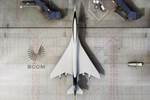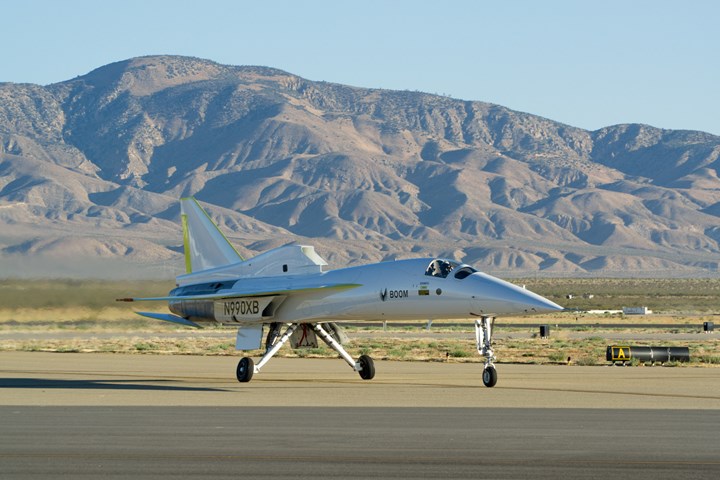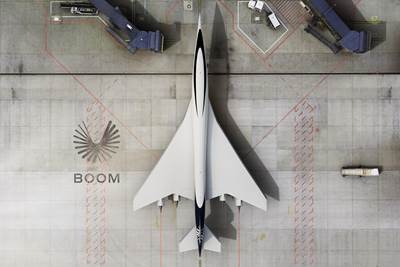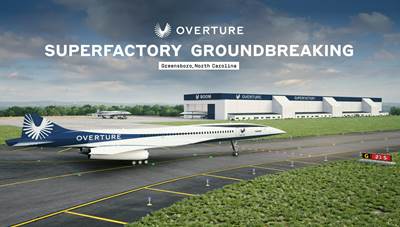Boom Supersonic advances flight preparations for composite XB-1 demonstrator
Since its rollout in 2020, the supersonic demonstrator has claimed several achievements, including a recent experimental airworthiness certificate and authorization for test pilot flights, further validating Overture’s development.
The XB-1 has undergone extensive ground testing since arriving, including taxi testing in August at the Mojave Air & Space Port in Mojave, Calif., U.S. Photo Credit: Boom Supersonic
Boom Supersonic (Denver, Colo., U.S.), the company building supersonic aircraft Overture, has announced the completion of several key milestones for XB-1, Boom’s technology demonstrator. XB-1 leverages 60 years of progress in airplane technologies like carbon fiber composites (visit this link for additional information on the aircraft’s composite use), advanced avionics and digitally optimized aerodynamics to enable sustainable supersonic travel.
Earlier this year, XB-1 was moved from the company's hangar in Centennial, Colo., U.S. to the Mojave Air & Space Port in Mojave, Calif., U.S. to continue preparations for flight. The aircraft has undergone extensive ground testing since arriving, including taxi testing in late August.
In addition to the ongoing testing, XB-1 recently received an experimental airworthiness certificate from the Federal Aviation Administration (FAA), following a detailed aircraft inspection. Boom has also secured letters of authorization to enable chief test pilot Bill “Doc” Shoemaker and test pilot Tristan “Gepetto” Brandenburg to fly XB-1. Moreover, letters of agreement with airspace authorities are in place allowing for flights of the aircraft over the Mojave desert. XB-1’s historic first flight will occur in the same airspace where Captain Charles “Chuck” Yeager first broke the sound barrier in the Bell X-1 and the Mach 3+, strategic reconnaissance SR-71 Blackbird first flew in 1964.
XB-1 features a carbon fiber and titanium fuselage measuring 71 feet in length.
XB-1 has provided the company with valuable learnings, including the development of a robust safety culture. In preparation for flight, Boom’s test pilots have completed hundreds of hours in the simulator for aircraft evaluation, operations development, training and human factors assessments to achieve the highest levels of safety. The test pilots also maintain flight proficiency in a T-38 trainer aircraft, the same aircraft that will be used as a chase plane for all flight tests of XB-1. To further increase safety, the test pilots will use the T-38 to practice formation flying.
“It's fitting that XB-1 is now progressing toward first flight at the Mojave Air & Space Port, home to more than 50 first flights and other significant aviation events,” Shoemaker says. “I’m looking forward to flying XB-1 here, building on the achievements of other talented engineers and pilots who inspire us every day to make supersonic travel mainstream.”
XB-1 features a carbon fiber and titanium fuselage measuring 71 feet in length. Its ogive (modified delta) wing enables safe operation at takeoff and landing as well as supersonic speeds. The three General Electric (Boston, Mass., U.S.) J85 engines that power XB-1 produce a combined maximum thrust of 12,300 pounds of force (lbf).
The supersonic demonstrator aircraft rolled out of Boom’s hangar in Centennial in October 2020. Since then, rigorous testing of all of XB-1’s internal subsystems has been completed. Upgraded landing gear and supersonic engine intakes were also installed on XB-1, both of which increase performance and safety.
Across its development, XB-1 has validated Boom’s approach to airplane design and enabled engineers to leverage advanced tools like computational fluid dynamics (CFD) which are critical components of Overture’s development. The sustainable supersonic airliner will fly at Mach 1.7, or about twice the speed of today’s fastest airliners, and is designed to run on 100% sustainable aviation fuel (SAF).
To view XB-1’s recent taxi testing please visit the Boom Supersonic YouTube channel.
Related Content
Carbon fiber in pressure vessels for hydrogen
The emerging H2 economy drives tank development for aircraft, ships and gas transport.
Read MorePlant tour: Spirit AeroSystems, Belfast, Northern Ireland, U.K.
Purpose-built facility employs resin transfer infusion (RTI) and assembly technology to manufacture today’s composite A220 wings, and prepares for future new programs and production ramp-ups.
Read MorePlant tour: Joby Aviation, Marina, Calif., U.S.
As the advanced air mobility market begins to take shape, market leader Joby Aviation works to industrialize composites manufacturing for its first-generation, composites-intensive, all-electric air taxi.
Read MoreMaterials & Processes: Composites fibers and resins
Compared to legacy materials like steel, aluminum, iron and titanium, composites are still coming of age, and only just now are being better understood by design and manufacturing engineers. However, composites’ physical properties — combined with unbeatable light weight — make them undeniably attractive.
Read MoreRead Next
American Airlines places order for 20 Boom Supersonic aircraft
American Airlines could potentially purchase up to 60 Overture composites-intensive, supersonic passenger aircraft if industry-standard operating, performance and safety requirements are met.
Read MoreDigital design, multi-material structures enable a quieter supersonic NASA X-plane
NASA’s composites-intensive X-59 QueSST experimental aircraft is set for its first flight by the end of 2022, after nine years of design, manufacture, assembly and testing by Lockheed Martin Skunk Works.
Read MoreBoom Supersonic begins construction of Overture Superfactory
Composite supersonic airliner Overture is on track to enter production in Greensboro, North Carolina by 2024.
Read More



























